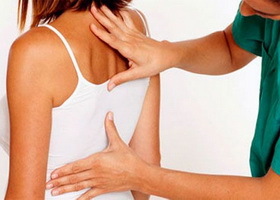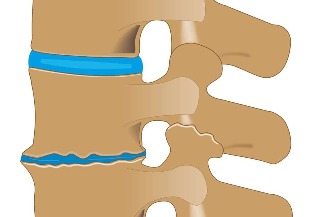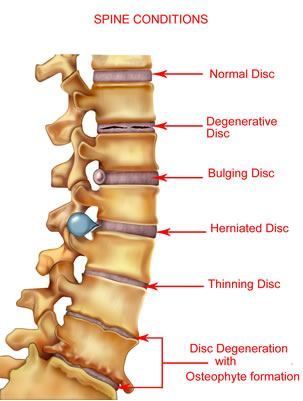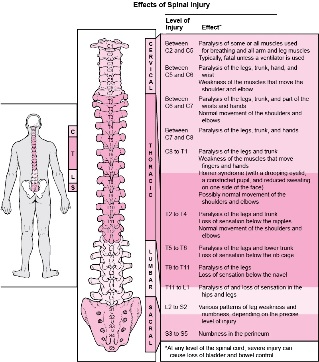
General information
Such a disease of the human musculoskeletal system as osteochondrosis is essentially a degeneration of the articular cartilage and nearby bone tissue, with frequent involvement of adjacent vessels, muscles and nerve endings in the pathological process. In principle, this term can mean a number of osteoarticular pathologies of various localization, including the joints of the extremities, but most often it is used to denote degenerative-dystrophic changes in the structure directly of the spine and, above all, the intervertebral discs.
As a result of the progression of intervertebral osteochondrosis, the human body loses its inherent shock-absorbing qualities, mobility and elasticity. In general, this spinal disease is widespread and in one or a different degree of severity it is present in most people by the age of 40. Depending on the affected segment of the spine in clinical practice, cervical, lumbar and thoracic osteochondrosis are distinguished, as well as their mixed forms, which are considered the most difficult.
Osteochondrosis of the thoracic spine, which we will talk about in this article, is the rarest form of this pathology, which, in particular, is due to the anatomical structure of the upper part of the human skeleton. Thus, in the chest area, the osteochondral system consists of 12 vertebrae, which are connected by means of joints with ribs, which with their anterior ends adjoin a relatively monolithic sternum. Such a skeletal structure provides enougha rigid and strong frame that protects the organs of the thoracic cavity (heart, lungs) from injury. In addition, the vertebrae of this segment of the spine are characterized by a small height and a significant length of the spinous processes, which gives them a view of closely spaced weaving. All this together limits the mobility of this part of the back and the negative impact of physical activity on it, protecting the intervertebral discs from destruction.

As another reason for the lower frequency of detection of osteochondrosis of the chest in a person, compared with lumbar and cervical osteochondrosis, physiological kyphosis (natural backward bending of the spine) appears in this area, adue to which most of the external load falls on the anterior and lateral fragments of the vertebrae and discs. With the development of a pathological process in the segment of the spinal movement, it is these areas that are mainly exposed to degenerationchanges, however, due to the absence of nerve endings and spinal cord membranes in them, pain is not often observed. However, in some cases, negative transformations in the thoracic segment of the spine affect posterior fragments of discs and vertebrae and / or vertebral-costal joints, which often lead to compression of the roots of the spinal nerves. In such conditions, osteochondrosis of the thoracic spine occurs with radicular syndrome, which is already accompanied by pain of various localization (sometimes very distant), as well as a violation of the functionality of many organs of the human body (liver, lungs, pancreas, heart, etc. ).
Due to such ambiguous and varied manifestations of thoracic osteochondrosis, doctors often call this form of pathology "chameleon disease", as it can skillfully disguise itself as symptoms of respiratory and digestive diseases, heart muscle, etc. In this situation, a correctly conducted differential diagnosis is very important, which, through various specific studies, will help determine the symptoms and treatment of osteochondrosis of the thoracic spine.
The tactics and effectiveness of further therapies will largely depend on the degree of progression of the degenerative-dystrophic process in the tissues of the spine. Having recognized the pathology in the initial stages of its development, it is significant to improve the patient's conditionit is quite possible with the help of simple physiotherapy techniques and physical therapy exercises, but in case of late detection, it may be necessary to perform an operationcomplex surgical. That is why physician-vertebrologists strongly recommend when any frequent and / or prolonged back pain as soon as possible seek help from a specialist.
Pathogenesis
The incidence of osteochondrosis of the thoracic spine in women and men is practically identical, since in the pathogenesis of this disease there is no gender predisposition to the onset of intervertebral disc degeneration. However, many years of clinical experience in the treatment of osteochondrosis indicate that its first symptoms in men appear at an earlier age than similar negative symptoms in women. In particular, this is due to the fact that osteochondral until a certain age, the tissues of the female body are protected by the hormone estrogen, a decrease in the level of which at the time of climacteric transformations acts as a trigger for problems with the spine.
According to statistical evidence, in general, intervertebral osteochondrosis in varying degrees of severity is found in most elderly people, which automatically classifies it in the group of age-related diseases. Meanwhile, the last time is followed by a significant "rejuvenation" of this pathology, until its occurrence in preschool. For this reason, it has not been possible to establish the exact etiology and initial pathogenesis of spinal osteochondrosis to date. At one time, more than a dozen theories of its origin and development were developed, including hormonal, infectious, mechanical, vascular, hereditary, allergic and others, but in practice none of them have found full confirmation.
Today, doctors explain the onset of osteochondrosis by the sum of complementary negative effects on the tissues of the spine, among which they emphasize the constant excessive load on one or more spinal movements segments formed by two adjacent vertebrae (upper and lower)and a disk located in the center of them. Paradoxically, such an overload can be a consequence both of the excessive physical work of the spine, and the result of its long-term finding in an unnatural position for the back. For example, prolonged work or study in a sitting position at the table is one of the primary factors in the development of degenerative-dystrophic changes in the structure of the intervertebral disc.
The initial formation or exacerbation of osteochondrosis of the thoracic spine can be affected by inappropriate nutrition, irregular development of the back and chest muscles, excessive weight (obesity), pathology of the lower limbs (for example, flat feet), back injuries, etc. In the pathogenesis of this disease, the disorganization of segmental blood circulation plays a significant role, which causes dehydration of the pulpy (gelatinous) nucleus, which in turn leads to loss of amortization qualities of the intervertebral disc, variation of loads on the surrounding fibrous ringand further gradual destruction of this segment of spinal motion.
In the process of its progression, thoracic osteochondrosis undergoes 4 successive stages of development, each of which is characterized by its own anatomical and morphological changes in the structure of the disc, adjacent vertebrae and facet joints. In addition, the negative metamorphoses that occur with this disease can directly affect other nearby tissues (muscular, vascular, connective) or indirectly affect the work of remote organs and systems of the human body. (intestines, heart, lungs, etc. ).

First degree
At the initial stage of the formation of thoracic osteochondrosis, microcracks are formed in the inner membrane of the fibrous ring, in which the nucleus pulposus gradually begins to penetrate, irritating the nerve endings in the distal layers of the fibrous rings and in the posterior longitudinal ligament. At this stage of the development of the disease, the patient may already feel pain directly in the middle of the back or apparent pain in the heart region. It can also be haunted by a feeling of convulsive contraction. in the back muscles.
Second degree
Osteochondrosis of the thoracic spine of the 2nd degree is characterized by further destruction of the annulus fibrosus, which is accompanied by instability of the spine, resulting from the excessive mobility of its affected vertebrae. Painful sensations from the 2nd stage of the development of the pathology intensify and may proceed as dorsalgia (mild persistent pain, aggravated by movements of the back) or dorsago (which arises abruptly against the background of a prolonged stay in one position, strong "shooting" pains).
Third degree
In the third period of thoracic osteochondrosis, a complete rupture of the structure of the fibrous ring occurs with the exit of the nucleus pulposus beyond its borders and the formation of an intervertebral hernia. Most often, such formations arise in the direction of the spinal canal, which leads to compression of the spinal cord, spinal nerves and adjacent vessels. This is accompanied by radicular syndrome (pain that radiates to different parts of the body), thoracalgia against the background of osteochondrosis (severe pain behind the sternum, resembling acardiac), myelopathy (sensory and motor disorders) and other symptoms of a neurovascular and muscle-toned. Fixed thoracic kyphosis, scoliosis, or kyphoscoliosis can begin at this stage.
Fourth degree
During the final stage of thoracic osteochondrosis, degenerative processes spread to the interspinous and yellow ligaments, other tissues of the spine and nearby muscles. Intervertebral disc dystrophy continues to progress, up to the scar and further fibrosis. Deforming arthrosis develops in the semilunar and intervertebral joints, osteophytes (bone growths) are formed on the processes of the vertebrae. The clinical picture in this period of the disease can be quite versatile, since the degree of damage to individual discs is often different. In uncomplicated osteochondrosis, fibrosis of the problematic disc can mark the passage of the disease to the stage of stable remission, but with the loss of normal function in one way or another. vertebral column.
Reasons
Thoracic osteochondrosis in men and women can develop due to the following predisposing factors:
- the natural process of physiological aging, accompanied by age-related changes in the structure of the bone-cartilage tissue of the spine;
- genetic predisposition to abnormal formation of spinal motion segments;
- a physically inactive lifestyle leading to dystrophy of the spinal muscles;
- strength sports involving excessive mechanical stress on the spine (mainly weight lifting);
- spinal injuries (even those that occurred in the distant past);
- endocrine disorders in the human body, which disrupt the nutrition of the tissues of the spine;
- significantly above normal body weight (obesity);
- unhealthy diet (deficiency of vitamins, minerals and fluids);
- pathology of the spine with its unnatural flexion;
- imbalance in the development of muscle structure;
- prolonged study or work in a sitting position with the body bent forward;
- physically difficult working conditions (constant and improper weight lifting);
- severe metabolic disorders;
- flat feet and other diseases of the lower extremities, which affect the redistribution of loads on the spine;
- vascular diseases that impair the blood supply to the back;
- severe infectious, allergic and autoimmune processes;
- frequent hypothermia;
- stressful situations and nervous breakdowns;
- bad habits and smoking.
Symptoms of osteochondrosis of the thoracic spine
Signs of thoracic osteochondrosis, due to the structural features described above of this segment of the spine, may not directly disturb the patient for a long time and appear only if the pathological process spreads to the lateral and / or posterior parts of the segmentsof movement of the affected spine and the transition of the disease to the second or third degree. In general, all the symptoms of thoracic osteochondrosis are expressed in the form of vertebral syndromes (painful effects directly correlated with functional disorders of the bone-cartilage tissue of the spine) and extravertebral or compression syndromes (negative phenomena arising from pathological impulses from the problematic segment of thevertebral column).
Vertebral syndromes
The vertebral symptoms of osteochondrosis of the thoracic segment of the spine are mainly manifested by two painful syndromes, called dorsago and dorsalgia.
Dorsago
It is an attack of acute and sudden pain, the so-called "low back pain", which is localized in the interscapular space and can occur at any time. Most often, dorsago syndrome affects patients who have been in a sitting position with the body tilted forward and sharply changing the position of the body. Patients describe the very moment of the attack as a "dagger strike" accompanied by a sharp spasm of the spinal muscles. In addition to severe pain, subjective sensations with dorsalexpressed by shortness of breath and a significant limitation of freedom of movement in the thoracic part of the back. Such an exacerbation of osteochondrosis with periodic attacks can last up to two weeks.
Back pain
This syndrome differs from the previous one in the gradual development of sensations of discomfort and pain, which can increase over the course of two to three weeks. The pain itself with back pain is not so pronounced, but its prolonged presence causes a constant feeling of anxiety. The back muscles, as well as during the back muscle, are subjected to significant stress, which can make the patient feel a lack of inhaled air. Back pain increases with trunk movements (especially when bending over), deep breathing, coughing, etc. Separately, upper back pain (the main localization of negative phenomena in the cervicothoracic segment of the spine) and lower back pain (the main localization of negative phenomena in the thoracolumbar segment of the spine).
Extravertebral syndromes
The extravertebral syndromes of thoracic osteochondrosis, due to the maximum extension of this part of the spine, can be very different, which greatly complicates the correct diagnosis of the disease. They arise as a result of mechanical compression of the corresponding nerve roots, neighboring vessels or the spinal cord itself. Symptoms of compression in men and women are usually similar and differ only when pathological impulses spread to the sexosphere (for example, in men, against the background of the disease, erectile dysfunction is sometimes noted). In almost all cases, extravertebral symptoms are caused by already formed intervertebral hernias, which most often appear in the lower thoracic regions, but in principle they can form in any vertebral motor segment from the D1 vertebra to the D12 vertebra. As you can see in the photo below, it is on the localization of osteochondrosis in them that the involvement in pathologythe process of certain systems and organs of the human body with negative manifestations characteristic of them.

Radicular syndromes
In the context of compression symptoms of thoracic osteochondrosis, root syndromes are most often and clearly observed, provoked by compression of the nerve endings in one or another segment of the spine. Depending on the concentration, suchpatient problems can be disturbed by the following painful phenomena:
- in case of violation in the area of the T1 vertebra - painful sensations and paresthesias from the motion segment of the upper thoracic spine most often spread along the suprascapular area in the area of one of the armpits to the elbow joint;
- in case of violation in the area of the T2-T6 vertebrae - pain like intercostal neuralgia can extend from this part of the spine along the interscapular region and surround the axillary and scapular zones in a semicircle, as well as 2-6 spaceintercostal to the sternum;
- in case of infringement in the area of the T7-T8 vertebrae - girdle pain spreads mainly from the lower level of the shoulder blades of the spine-costal joints to the upper parts of the costal arch and affects the epigastric region, where it provokesmuscle defense (strong muscle tension);
- in case of infringement in the region of the T9-T10 vertebrae - intercostal neuralgia expands from the segments of the lower thoracic spinal movement to the lower parts of the costal arch and beyond to the umbilical region, changing the tone of the central section of the abdominal muscles;
- in case of infringement in the region of the T11-T12 vertebrae - the pain also emanates from the spinal movement segments of the lower chest and reaches the hypogastric (under the stomach) and inguinal regions along the corresponding lateral zones of the chest.
In addition to pain, very often radicular syndromes of thoracic osteochondrosis are accompanied by negative symptoms from some internal organs of the abdominal cavity and / or chest. Moreover, in some cases, such symptomsare so similar to the pathological manifestations of other diseases that it is practically impossible to accurately recognize their belonging without direct research. For example, the medical literature describes a case of unwarranted conducting appendectomy (surgery to remove the appendix) according to the unique clinic of acute appendicitis, which actually turned out to be one of the pronounced syndromes of osteochondrosis.
Thus, when the osteochondrosis process is localized in the upper thoracic region of the spine (T1 to T4), patients may experience pain and / or various discomfort in the esophagus or pharynx, which are often perceived as the presence ofa foreign body. Such sensations are often paroxysmal (sometimes permanent) and intensify with a severe load on the problematic part of the back. Sometimes the manifestations of radicular syndrome in the upper thoracic segment are confused with obstructive bronchitis or pneumonia, since a reflex cough with osteochondrosis of the thoracic region and chest pain resemble the symptoms of this group of diseases. In addition, chest pain can manifest itself in the form of thoracalgia, which reminds its intensity is an attack of angina pectoris, pulmonary thromboembolism, myocardial infarction, and other similar pathologies of a serious nature, which require a detailed differential analysis by doctors.
Patients with osteochondrosis in the middle thoracic segment of the spine (T5 to T7) very often experience discomfort and pain in the solar plexus and stomach, which are called vertebrogenic gastralgia. At the defeat of the spinal movement segments T8-T9, it is possible to develop pain in the duodenal region, called - vertebrogenic duodenalgia. . . Both those and other painful sensations in different patients or at different times can vary in intensity from mild and "aching" to extremely acute. They intensify, as a rule, with a prolonged stay of the body in one position (sitting at a table, lying on the back, etc. ), in case of sudden movements of the body, and also at the time of sneezing or coughing. Often these pains are accompanied by paresthesias. (numbness, tingling, burning) in the center of the abdominal wall.
With radicular manifestations of osteochondrosis in the lower thoracic region of the spine (T8 to T12), some patients may complain of pain in the lower abdominal cavity, mimicking intestinal upsetor pathology. Sometimes the pain spreads to the gallbladder and is localized in the posterior region of the right hypochondrium. Even less often, patients experience pain in the suprapubic region similar to the pathological bladder clinic. As in the previous case, the nature of such pain can vary in a fairly wide range (from mild to intense) and their severity increases with prolonged physical or static stress on the spine, sneezing, coughing, etc.
Compression myelopathy
This compression syndrome of thoracic osteochondrosis is quite rare and is a compression of the spinal cord directly from the resulting intervertebral hernia. . . Its characteristic symptoms at the beginning of the formation are expressed by local pain in the corresponding area of the back or girdle pain in the problem area, as well as a feeling of weakness and / or numbness in the legs. With progression, the pain intensifies, can affect the intercostal vallespazio, abdominal organs, groin area and significantly felt in the lower limbs. In severe cases with compression myelopathy, dysfunction of the pelvic organs may develop, leading to disruption of defecation and / or urination processes. In addition, severe superficial and deep paraesthesia and sensory disturbances can occur, up to spastic paresis in one or even both legs.
Vascular compression
Compression of the vessels adjacent to the thoracic segment of the spine leads to myeloischemia, as a result of which the blood supply is interrupted and thus the proper nutrition of the spinal cord. The manifestations of this syndrome are actually completely repeating the symptoms of compression myelopathy, and are mainly characterized by pelvic disorders, as well as loss of sensation in the lower limbs and decreased functionality. Patients often describe this problem with the phrase - "legs fail".
Vegetative syndromes
In a number of cases, with thoracic osteochondrosis, the vegetative nerve nodes (ganglia) are damaged, as a result of which the patient can experience a wide variety of negative symptoms. These can be various paresthesias. , itching and changes in skin pigmentation in the area of the problematic ganglion, burning of one half of the body, local temperature disturbances, muscle hyper or wasting, disorganization in the work of the limbs or internal organs, etc. According to his, these visceral vertebrogenic symptoms are similar to the manifestations of radicular syndromes, but differ from them in the absence of a clear localization and in the presence of secretory and motor disorders. When involved in the pathological process of a stellate knot affecting the upper thoracic vertebrae, there may be abnormalities in the arms, upper chest, and heart. In case of damage to the lower thoracic ganglia, functional disturbances of organs of the small pelvis, abdominal and thoracic cavity, as well as trophic changes in the lower limbs and the rest of the body can occur.




































